
By Nik DeCosta-Klipa, Boston.com Staff
November 20, 2015

By Nik DeCosta-Klipa, Boston.com Staff
November 20, 2015
| Webmaster's Note: The following is a reprint of an article presented in the Boston.com news website. The original is now cluttered with ads and with links that either no longer work or that require the user to login to it, hence this reprint. If you would nevertheless prefer to view the Boston.com site, please click here. |
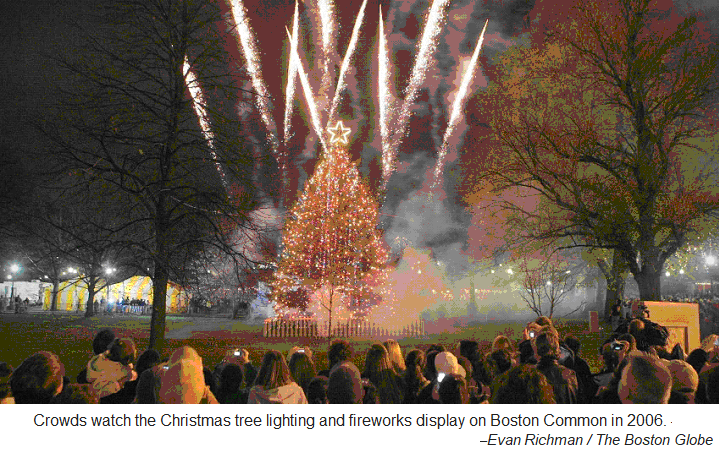
Boston’s Christmas tree arrives Friday on the Common after a three-day, 660-mile haul from Nova Scotia. The
tree arrives, as it has every year for the last 45, free of charge.
This year’s 49-foot white spruce (donated by a former Boston Marathoner) is the latest gift of thanks from
Nova Scotia to Boston for the city’s help during the deadliest non-natural disaster in Canadian history: the
Halifax Explosion.
“The people of Halifax have never forgotten how Boston responded during our moment of need," Zach Churchill,
Nova Scotia’s minister of Natural Resources, told Boston.com.
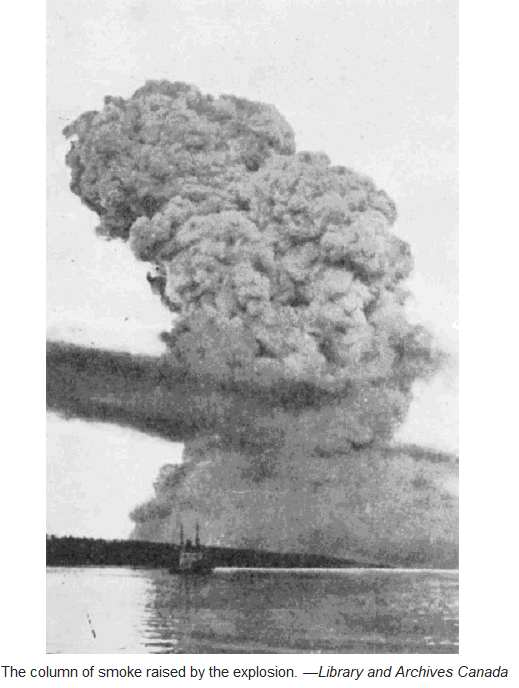 The morning of December 6, 1917 was cold with a “slight southerly wind," recalled a Boston Globe
article in 1967, as most December mornings are in Halifax. With a population of 50,000, the booming port city
was the largest in Atlantic Canada. According to the Canadian Broadcasting Corp. it attracted constant mid-WWI,
trans-Atlantic traffic because of its naturally deep harbors that were relatively easy to protect.
The morning of December 6, 1917 was cold with a “slight southerly wind," recalled a Boston Globe
article in 1967, as most December mornings are in Halifax. With a population of 50,000, the booming port city
was the largest in Atlantic Canada. According to the Canadian Broadcasting Corp. it attracted constant mid-WWI,
trans-Atlantic traffic because of its naturally deep harbors that were relatively easy to protect.
As a port, Halifax was perhaps too successful; harbor traffic control couldn’t keep up.
The SS Mont-Blanc — a 320-foot French freighter loaded with nearly 6 million pounds of explosives,
including 500,000 pounds of TNT — was waiting to enter Halifax’s harbor that cold, Thursday morning. The CBC
called the ship’s manifest “a recipe for a giant bomb," but it flew no flags warning of its cargo, so it
wouldn’t be made a target for German attack.
Inside the harbor was the Norwegian relief ship SS Imo, waiting for the anti-submarine nets to be
lifted so it could depart. The steamship planned to collect aid supplies in New York to bring back to Belgium,
but was running behind schedule.
After the nets were lifted, Imo departed, increasing its speed beyond the legal limit in the harbor
as it exited the crowded “Narrows" channel that opened up to the ocean. After it agreed to pass one oncoming ship
on the left, the “wrong" side, Imo was forced to stay in the opposite lane to avoid a tugboat that was
pulling away from shore. The route, unbeknownst to Imo, quickly became a crash course, per the CBC:
Then, through the morning haze, Imo faced Mont-Blanc moving up the Narrows.
Mont-Blanc blew its whistle once, to say it had right of way and would maintain its course: Imo should move to the right. But Imo blew its whistle twice in reply — translation: I am staying where I am.
There was a flurry of whistles between the two ships. Then, almost at the last minute, Mont-Blanc turned hard to the left ... and Imo reversed its engines — hard astern.
If only one of these moves had been made, the two ships would have avoided a collision – barely.
But the combination of last-ditch efforts made a collision inevitable.
The two ships struck, Imo grinding into the starboard bow of Mont-Blanc. The sparks immediately
set an acid and fuel fire on the French freighter. The crew, who spoke no English, abandoned the ship, as it
drifted toward shore. Despite the crew’s frantic gestures, crowds drew on both sides of the harbor to watch the
vessel, spewing a column a grease-colored smoked into the air. At least two ships, unaware of the ship’s cargo,
sent crews to investigate the burning ship, as it collided into the harbor’s Pier 6.
Roughly five minutes after 9 a.m., the Mont-Blanc exploded.
“It was the largest manmade explosion at the time," Churchill said.
Everything within more than a mile and a half radius — homes, shops. a 10-story sugar refinery — was
completely obliterated.
“The Mont-Blanc’s steel hull burst sky-high, falling in a blizzard of red-hot, twisted projectiles on
Dartmouth (an urban community) and Halifax," according to the CBC, killing 1,500 people immediately. Hundreds
more would die in the subsequent days due to the explosion and the fires that engulfed Halifax’s North End.
“The sight was awful, with people hanging out of windows dead. Some with their heads missing, and some thrown
onto the overhead telegraph wires," a firefighter recalled at the time.
The explosion launched parts of the ship miles away. The ship’s anchor — now a monument — landed more than
two miles away; a gun barrel landed more than three miles away. Most windows within 50 miles were shattered,
according to a CBC article, and the explosion was felt or heard across Nova Scotia, as far as Cape Breton, more
than 200 miles away.
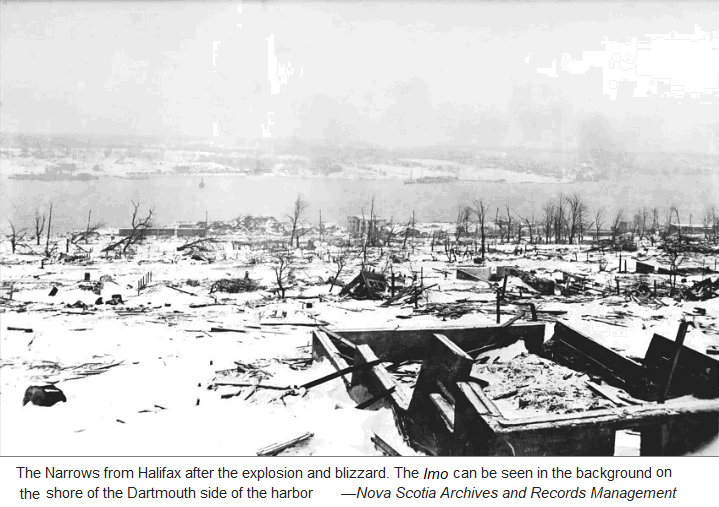
According to the CBC, 9,000 people were injured by the blast, as well as “falling buildings and flying shards
of glass."
Churchill said that his great-grandmother, pregnant with his grandfather at the time, suffered burns and a
concussion due to the explosion.
“She was far enough away that she wasn’t killed, but a lot of people weren’t so lucky," he said. “It touched
the lives of a lot of Nova Scotians outside Halifax."
To this day, the Halifax explosion remains one of the largest non-nuclear explosions in human history — and
the third deadliest. The city was devastated.
Reports of the explosion traveled quickly.
“Halifax Swept By Flames After Explosion, 2000 Dead," read a Boston Globe headline the next morning.
Despite an oncoming blizzard that would cut off Nova Scotia, Boston Mayor James Michael Curley sent a message
to the U.S. representative in Halifax hours after the explosion, per a Globe article December 7.
“The city of Boston has stood first in every movement of similar character since 1822," Curley wrote, “and
will not be found wanting in this instance. I am, awaiting Your Honor’s kind instruction."
Curley did not fall through on his pledge.
"Boston was first to respond," Churchill said.
Curley and Massachusetts Gov. Samuel McCall composed a Halifax Relief Committee to raise funds and organize
aid. Relief ads were printed in the Globe. McCall reported that $100,000 had been raised within the first
hour. After speaking with President Woodrow Wilson, Curley was able to secure a $30,000 carload of Army blankets
to send to Halifax.
Tracks through the Northeast were cleared for a train departing North Station 12 hours after the explosion.
The train brought 30 “of Boston’s leading physicians and surgeons, 70 nurses, a completely equipped 500-bed
base hospital unit and a vast amount of hospital supplies" for the estimated 20,000 destitute survivors,
reported the Globe.
The train was scheduled to reach Halifax in a record 22 hours, but was delayed by deep snow drifts brought by
the blizzard. It arrived the morning of December 8, the first non-Canadian relief train to arrive, to two-square
miles of “burned-out, blackened ruins," which had just been hit with 16 inches of snow, recalled a 1967 Globe article. Hospitals were already overflowing and a local school had to be used as a morgue.
Relief workers were organized into groups to deal with basic necessities and quarters were arranged for
doctors and nurses in private homes outside the hospital. Within less than a day of their arrival, a
fully-equipped and running impromptu hospital had been set up in a former military officer’s residence, reported
the Globe.
On December 9, by the time a second train arrived, Halifax announced it had enough doctors and clothing for
its immediate needs, and the Globe reported the city was “rallying bravely" from the disaster. Total
relief contributions from Massachusetts totaled over $750,000.
The Boston Symphony even performed a sellout benefit concert the next week for Halifax relief, according to
the Globe.
“On behalf of the Government of Canada, I desire to convey to Your Excellency our very sincere and warm
thanks for your sympathy and aid in the appalling calamity which has befallen Halifax," wrote Canadian Prime
Minister Robert Borden to McCall on December 9.
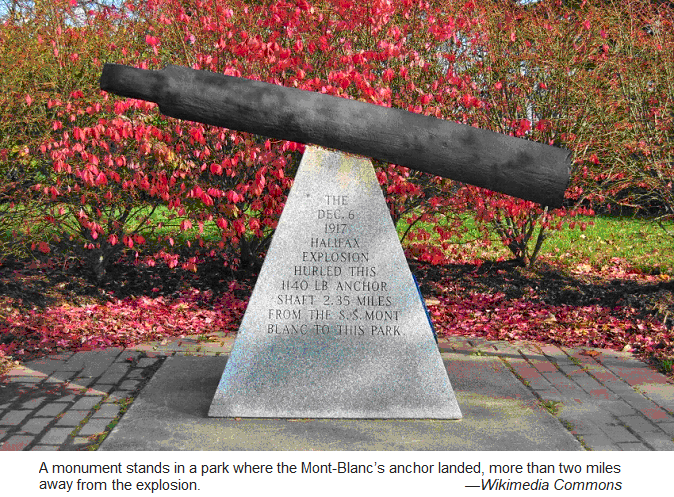
The tradition
One year later, Nova Scotia sent a return gift to Boston: a Christmas tree.
And in 1971, it became an annual tradition, a symbol of Nova Scotia’s gratitude, said Churchill.
“In a small community, when something happens to a family, it’s all about casseroles and hugs," Roseann
Misner, the donor of Boston’s 2010 Christmas tree, told the Globe. “When the explosion happened, it was in the
form of the relief effort from Boston."
Now, throughout the year, an employee in the Nova Scotia Department of Natural Resources — with the title of
“Christmas Tree Specialist" — keeps an eye out for a worthy evergreen.
When they find it, the province holds a celebratory tree cutting ceremony and, the next day, a send-off
parade in downtown Halifax. The festivities even include
@TreeForBoston Twitter and Facebook accounts to follow its
journey to the Common.
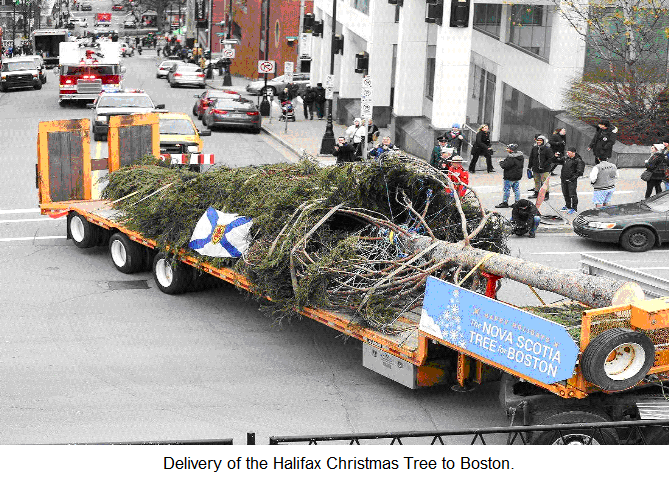
Churchill said that it’s a tradition that is highly celebrated in Nova Scotia and a great honor for the
landowner from where the tree comes.
“This year in particular, given the recent events in Paris, everyone was really focused on the season of
spirit, compassion, and generosity," he said.
“There’s a great sense of pride here to continue to show Boston thanks."
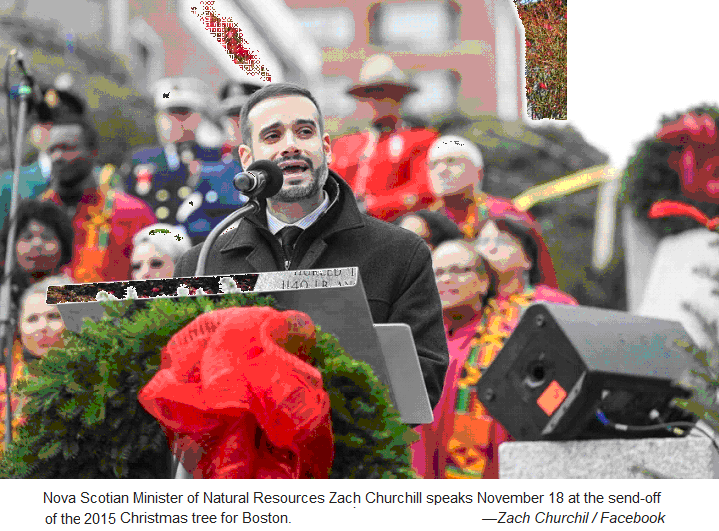
Webmaster's Note: The following are comments provided by one of the
readers of the Bostom.com article. They're being provided to help felsh out some of the details of the disaster
which the Boston.com article didn't do.
Also: If you're interested in learning more about the Halifax
Explosion, we recommend "The Great Halifax Explosion" by John U. Bacon, ©2017.
clondres
29 November, 2018
It has been 101 years. This was told in Yankee Magazine last year and with a bit more accuracy and feeling.
Yes, a train went a couple of days later, delayed by a snow storm with more medical help and others, but Boston
sent a ship less than 24 hours after the explosion knowing some thing dreadful happened and no one was
communicating from Halifax via telecommunications [which was 'the' method of being in touch that long ago.] The
first ship went up with doctors & nurses and the second ship carried glass and lumber. Bostonians helped rebuild
the entire area for almost a year. The trees have been selected each year with the utmost of care, in parts of
Nova Scotia, like Ainslie Glen on Cape Breton, and sent as a 'Thank You' from Nova Scotia, along with many
handwritten thank you notes yearly from Haligonians and the Waycobah Mi'kmaq First Nation people. The Canadian
Government officials, RCMP, and American officials take part in the Boston tree lighting and have for many years.
I felt using in this story, more than once, the word 'free' was simply tacky. Also, words like port side and
starboard side should have been used in telling of the collision. The Mont Blanc docked outside the harbour until
7:00 a.m. as was the rule before it began to enter the 'narrows' and it was an accident. The telling of the
accident in this story I find sounds rather misinterpreted, a bit ignorant and fault-finding. 'Ashpan Annie'
(a little 2 year old who was Anne Welsh) might have also been mentioned, and was found more than a day later in
warm ashes under an iron stove [as everyone had that type of stove] when the weather had turned very cold on
December 7th, and the warm ashes helped keep her alive. She was known as Ashpan Annie the rest of her life. I highly recommend reading the publication by Bill Scheller in Yankee Magazine, December 2017. As the article states atop, 'Every Tree Tells A Story'. My late husband and I often went into Boston to see the tree lighting usually at the end of November in The Commons and it is a memorable time still today, 101 years later as well as are the preserved historic government buildings.